Site menu:

May 2014 Newsletter
Common Scoters.
Madness at Red Rocks Part 2.
April Bird News.
Forthcoming Events.
Latest Newsletter.
Common Scoters
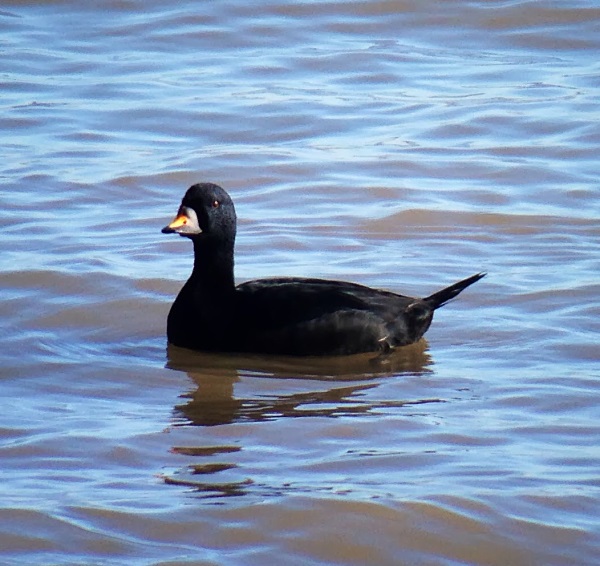
It's been a great winter for Common Scoters Melanitta nigra off the mouth of the Dee Estuary with no less than seven counts higher than the previous record number of 5,650 which had been recorded on April 5th 2008. But the 27,000 seen from Hilbre on March 3rd this year was one of those great wildlife spectacles that will always remain in the memory of those who saw it. There was an exceptionally high spring tide that day together with a flat calm and clear weather - so seeing conditions were ideal. As the spectacle unfolded there were hundreds of Scoters quite close in to the north end of Hilbre in constant motion when suddenly there was a massive movement of 15,000 all in the air together flying east, that still left 12,000 in huge rafts on the sea. Awesome!
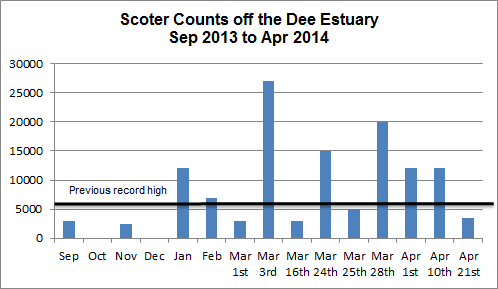
See Video http://youtu.be/eQr1usVqKME

see - http://www.hilbrebirdobs.blogspot.co.uk/
By any standards this was an exceptional number, so where did these birds come from? The short answer is just 20km down the coast in Colwyn Bay where several thousand are regular visitors. A look at the graphs below show that at both locations there has been a definite increase in numbers in recent years and it would seem likely that the same birds are moving between the two areas.
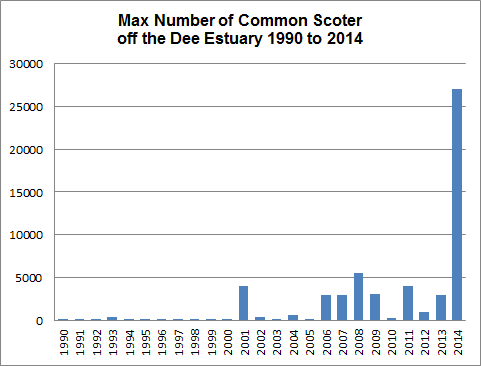
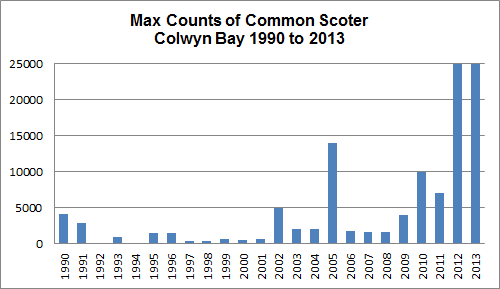
But we need to put these counts into perspective. As part of the Envionmental Assessments required for the then proposed off-shore windfarms in Liverpool Bay a series of Aerial Surveys were carried out by Wildfowl and Wetlands Trust Consulting between 2001/02 and 2006/07. The average max counts for Liverpool Bay from those surveys was around 54,000, including a high count of 79,136 in 2002/03. These were far higher than any previous numbers recorded simply because a large number of these birds are out of sight of land particularly off Blackpool. As a consequence of these high numbers, plus the presence of over 1,000 Red-throated Divers, Liverpool Bay was declared a Special Protection Area under the EC Birds Directive in 2010. So it is good to know just how important Liverpool Bay is for Common Scoters, and it is good that we have been seeing large numbers locally this winter.
Common Scoters breed across the western half of Siberia and winter in the Baltic Sea and on the eastern Atlantic coast from Norway down to north-west Africa, total numbers are difficult to estimate but the most recent put them at 550,000, much lower than the 1,600,000 normally quoted. In this country Liverpool Bay is the most important area for them with the next most important site being Carmarthen Bay with typically 20,000 present. Counts from the latter site suggest that birds start to leave there during January and it could well be that they then move north to Liverpool Bay were max numbers are recorded in late winter and early spring. As always with birds the true situation is more complicated and not fully understood, with 34,049 counted at Carmarthen Bay in March 2011 contradicting the above theory! The truth is that we know little about the movements of these birds, but with many over-wintering much further south than the UK it seems likely that many of these also pass through Liverpool Bay on their way to breed. It is also noticeable that we can get high counts in September when birds are returning, with 3,000 observed from Hilbre on Sep 21st 2013 a good example of that.
Scoters and Wind Farms
In Liverpool Bay Scoters and Windfarms seem to be inexorably linked. For example, the above mentioned aerial surveys discovered a previously unknown flock of c50,000 at Shell Flat, off Blackpool, and their presence contributed to the cancellation of the proposed 90 turbine windfarm there. Locally, if you look out from Point of Ayr, Hilbre or North Wirral you will see an ever increasing number of turbines and you might ask whether these are having a positive or negative effect on the Scoters.
Windfarms can undoubtedly have a positive effect on the sea life of the area. Fish numbers increase as they are protected from trawling, in these days of continuing over fishing that has got to be a good thing. Additionally, the base of the turbines, which are often surrounded by boulders to prevent scouring, act as a new reef where shellfish can grow and fish larva find shelter. On the negative side birds flying at rotor height can be killed although Scoters do usually fly well below any danger. But just the presence of the turbines and their associated boat movements, particularly at the construction stage, means birds usually avoid windfarms and thus a large area is effectively lost to them both as a feeding area and as a migration route.
As far as Scoters in Liverpool Bay are concerned the current construction of the huge 160 turbine Gwynt-Y-Mor wind farm off the North Wales coast may well be resulting in birds out there being pushed nearer the land, and perhaps further east, thus resulting in the increased number recorded from the shore. However, research in Denmark suggests that the birds do eventually get used to turbines, although it is doubtful if they would ever go close enough to make use of the shellfish growing immediately underneath. Interestingly, the aerial surveys carried out before windfarm construction began, indicated that the large majority of Scoters off North Wales and Wirral were located relatively close to the coast and inland of where the windfarms now are. Nevertheless, their presence could be having a major effect on migration routes with Gwynt-Y-Mor effectively blocking the route between Colwyn Bay and Shell Flat. Perhaps that is why we are seeing more birds off the Dee Estuary as the scoters are being forced to go east around the new massive windfarm. It is a pity the aerial surveys stopped in 2007 as it would have been fascinating to see exactly what effect the windfarms are having on the distribution of Common Scoters right across the Liverpool Bay SPA.
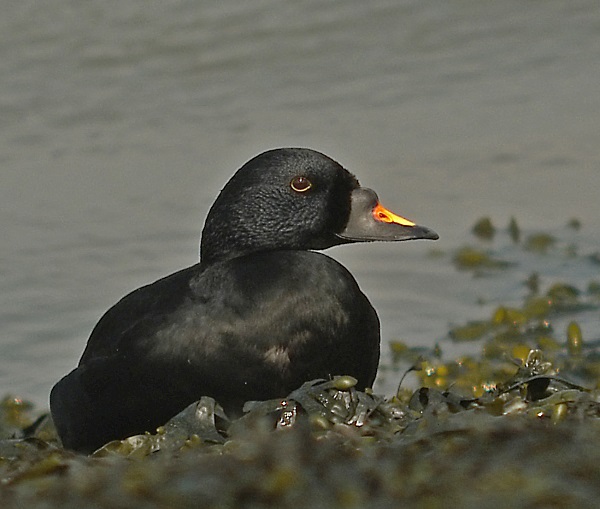
Sources of Information
1. Hilbre Bird Observatory - http://www.hilbrebirdobs.blogspot.co.uk/.2. Richard Smith; Common Scoters, Liverpool Bay SPA and Windfarms - Dee Estuary Website July 2008.
3. Taej Mundkur and Szabolcs Nagy et al., Waterbird Population Estimates Fifth Edition, Wetlands International 2012.
4. BTO, WeBS Report Online, http://www.bto.org/volunteer-surveys/webs.
5. Cheshire and Wirral Bird Reports, 1967 to 2012, CAWOS.
6. Clwyd Bird Reports/North-east Wales Bird Reports - various between 1990 and 2012.
7. Changes in bird habitat utilisation around the Horns Rev 1 offshore wind farm, with particular emphasis on Common Scoter, University of Aarhus - Denmark, NERI, 2007.
8. Positive environmental impacts of offshore wind farms, EWEA, 2013.
9. Liverpool Bay SPA, Advice under Regulation 35 (3) of the Conservation Habitats and Species Regulations 2010, Natural England and Countryside Council for Wales.
10. Aerial Surveys of Waterbirds in Strategic Windfarm Areas:2007, WWT Consulting.
11. Waterbirds in the UK; BTO, RSPB and WWT; Reports for 2000-01 to 2006/07.
12. M.J. Kaiser et al., Distribution and behaviour of Common Scoter Melanitta nigra relative to prey resources and environmental parameters; Ibis (2006), 148, 110-128.
13. Burbo Bank Extension Offshore Wind Farm, Agreed Statement of Common Ground with Natural Resources Wales and Natural England on red-throated diver, DONG energy, March 2014.
14. A.J. Musgrove et al., Overwinter population estimates of British waterbirds, British Birds 104 July 2011.
15. David Cabot, Wildfowl, The New Naturalist Library, Collins, 2009.
Richard Smith
Top of Page
Madness at Red Rocks - Part 2
For those who haven't already done so I urge you to read my first article on this subject published in the April Newsletter - Madness at Red Rocks.
We've have had a temendous response to that article and I know many people have contacted both Natural England (NE) and Cheshire Wildlife Trust (CWT) with their opinions - for which many thanks. Many thanks also for everyone who has contacted myself directly offering support, this is very much appreciated.
Currently it is fairly quiet at Red Rocks. We understand that CWT are to review their management plan and there has been a rather vague offer of consultation at some stage. We do hope this is a meaningful and full consultation where there is a full and frank discussion with an agreement at the end of it - and we would strongly suggest that there must be a full survey of the site before any further work takes place. We do not want what we got in our meeting in March where there was no consultation and a breakdown in trust - as a direct result of that farce I wrote that 'Madness at Red Rocks' article. It is also essential that we see all the relevant documents which NE and CWT have produced involving this work so we know exactly what was agreed prior to the work starting in February, and exactly what is planned for the future. We have asked for these through 'Freedom of Information', the request was made on April 1st but nothing had arrived by April 30th which seems excessively slow.
Below are a few extracts from some of the emails received:
To CWT and NE:
"I appreciate that at Red Rocks you
will have management plans to follow and that sand dunes may be rare
habitat on the peninsula but I also think that it is vital for you to
consult with local users of the reserve including the many dedicated
local birders who have helped record birds there over the years as they
will have valuable local knowledge. I recall seeing my first
Wryneck in the bushes you intend to clear and more importantly seeing
breeding grasshopper warblers. In the 1970’s there
were several local areas where grasshopper warblers nested but the
conversion to horse paddocks and general tidying up has meant
that few if any on these areas now remain. Red Rocks is a
vital breeding area for this declining species."
-----------------
"Picking up on one of the points
raised in the article, I can vouch that the trees you have recently
felled have been there for many years. I recall
them there in the early 1970s and, even back then, Mistle thrushes
nested in them."
-----------------
"Having spent many hours in the Red
Rocks area as a school child, in the early 1970s, and later as part of
my 'beat' as a new police constable, I have been appalled to read of
the recent felling of the poplar trees."
-----------------
"I have discovered the joy of bird watching only recently and rely on
the expertise of enthusiasts such as Richard Smith who runs the dee
estuary web site. Richard is seeking to have the site reassessed and to
allow local experts such as himself to impart their unique knowledge of
the site to enable best policy to be implemented. He has the support of
everyone I have spoken to on this matter."
-----------------
"I have read your shocking article about the damage to Red Rocks. I had been already aware of this but was shocked to hear of the absolute lack of any meaningful consultation prior to this and also the mistruths that have been circulated by the CWT. I clearly remember birding at Red Rocks as long ago as 1976 and the poplars being a prominent feature then. I am aware that Nature England is little more than a government quango but would have expected better from CWT."
"I've just read the piece about Red Rocks on the Dee Estuary website, I am staggered by what basically amounts to mindless destruction of a very important wildlife habitat."
-----------------
"The trees were important not only for the shelter they provided for birds, but a fine ground-cover of interesting plants was becoming established."
-----------------
Richard Smith
Top of Page
April Bird News
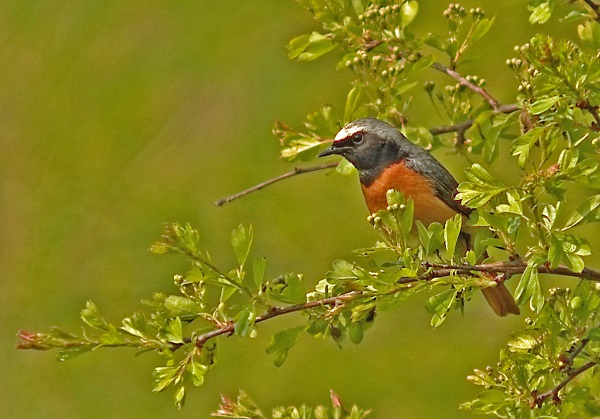
It was a great month for Common Redstarts with a total of 42 records, this compares to a total of 27 for the whole of the spring last year, in itself a good number. Although we haven't had a day when there was a spectacular fall of migrants birds were coming through steadily all month. We had our first Yellow Wagtails and Lesser Whitethroats on the 11th and first Whinchat on the 15th with 15 Whinchats at Red Rocks on the 28th an excellent number. The first Grasshopper Warbler was seen on the 12th and seven were heard reeling at Red Rocks on the 18th. We are very hopeful some of these Red-listed birds will stay to breed here this year, although if Cheshire Wildlife Trust and Natural England have their way it will be the last time they will. There was a good passage of White Wagtails with 135 on Hoylake beach on the 11th and 125 at Gronant on the 24th the highest counts. A Wood Warbler was in woods at Newton at the end of the month. However, we still wait for our first Cuckoo and Swift.
| Species | 2014 | Location (2014) | 2013 | 2012 |
|---|---|---|---|---|
| White Wagtail | 8th March | Hilbre | 14th March | 8th March |
| Wheatear | 10th March | Leasowe Lighthouse | 17th March | 9th March |
| Willow Warbler | 12th March | Burton | 6th April | 20th March |
| Swallow | 19th March | Connah's Quay | 10th April | 17th March |
| Sand Martin | 20th March | West Kirby | 28th March | 28th March |
| House Martin | 29th March | Gronant | 12th April | 4th April |
| Whitethroat | 4th April | Leasowe Lighthouse | 15th April | 1st April |
| Cuckoo | 13th April | 14th April | ||
| Swift | |
17th April | 26th April |
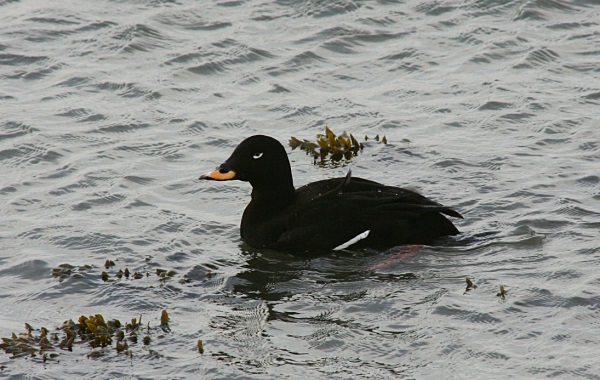
Other migrants, on their way to Iceland, included Black-tailed Godwits with up to 970 at West Kirby and Pink-footed Geese with 3,500 heading north early in the month.
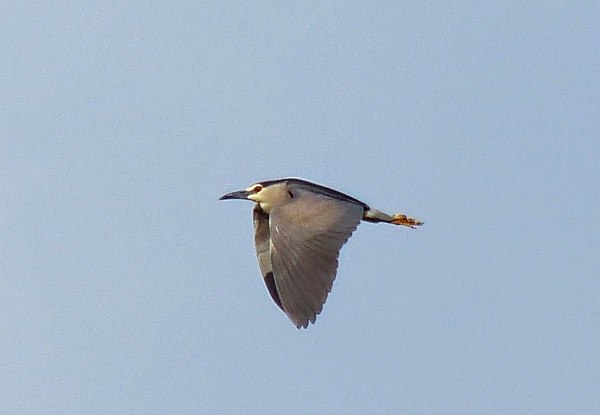
see lighthousebirding blog.

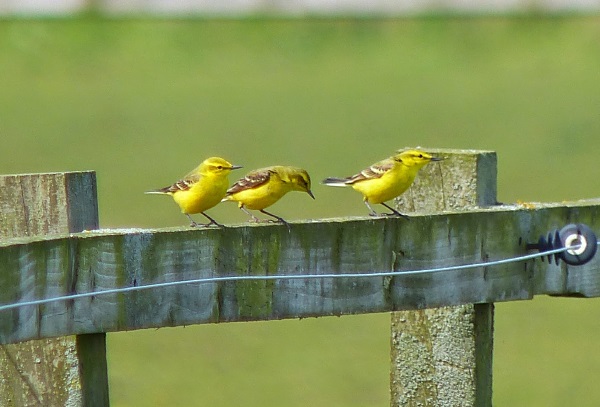
see lighthousebirding blog.
Richard Smith.
What to expect in May
Out to sea we can get large movements of Gannets and given a good blow Manx Shearwaters as well. Little Terns will return to Gronant and will start breeding by the end of the month.
The spring migration is still well underway and we can get some spectacular numbers of Wheatears, and we can get days when the sky just seems to be full of Swifts with a total of thousands.
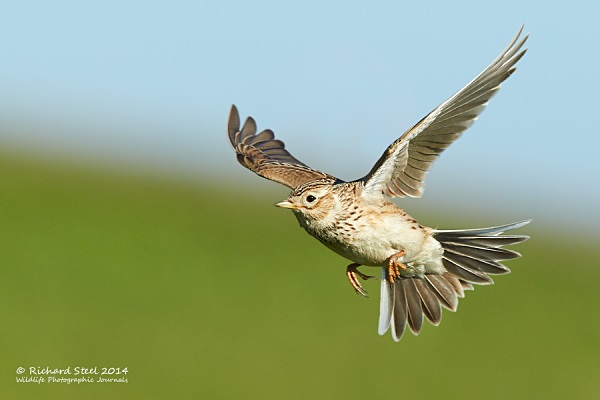
See wildlifephotographic.blog
Top of Page
Forthcoming Events
May Highest Spring Tides (Liverpool)
Also
see Tides
page.
1st May, 13.18hrs (BST), 9.3m.
16th May, 12.55hrs (BST), 9.3m.
17th May, 13.39hrs (BST), 9.3m.
Forthcoming Events
Organised by the Wirral
Ranger Service , Flintshire
Countryside Service and the
RSPB (Dee Estuary):
All these events and walks have bird interest, even those not
advertised specifically for birdwatching. No need to book for these
events unless specified - please check below.
Also see 2014 Events Diary.
Take Tea with the RSPB:
Walk across the sands to Hilbre Island where the RSPB will be serving tea and biscuits during the above date and time. They will be on hand to show you some of the island’s unique wildlife and will tell you about the work that the RSPB are doing at their fantastic reserve at Burton Mere Wetlands. There is no need to book, just turn up. Suitable clothing and footwear are essential for the walk out and please note – this is not a guided walk. Remember to bring money for the tea!
For further information, please telephone Wirral Country Park on (0151) 648 4371
Saturday 24th May 10:00am – 2:00pm
Spring on Hilbre:
Join the Coastal Rangers, RSPB and Wirral Wildlife on this low tide walk to
Hilbre Island. We will see the flowers and plants that flourish on this tidal island, learn about the birdlife and the island's history. Suitable clothing, footwear and sunblock are recommended for this walk. Bring lunch and something to drink along with binoculars if you have them. Places are limited and a suggested donation of £3 will be gratefully received on the day for this event.
Booking is essential (0151) 648 4371